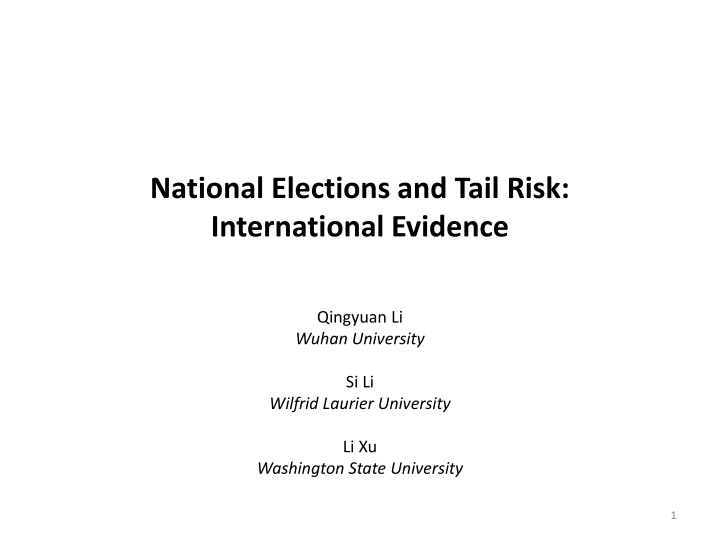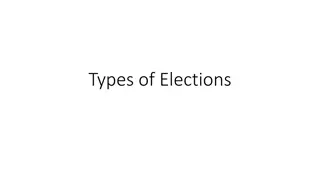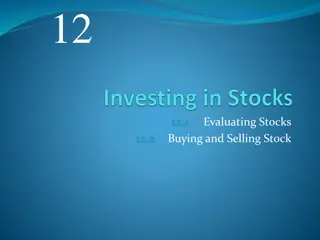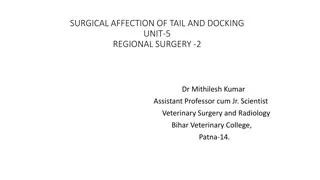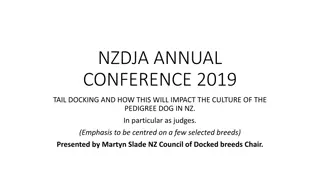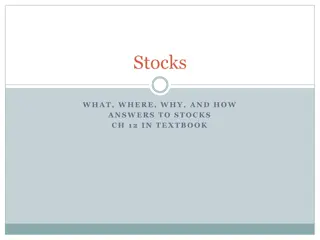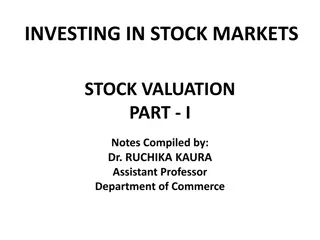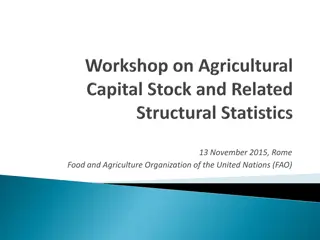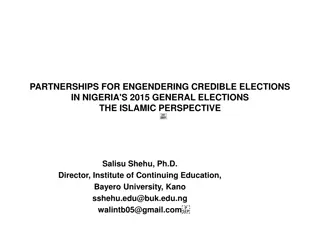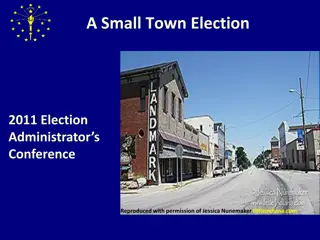Stock Tail Risk around National Elections Worldwide
Investigating changes in stock tail risk at the individual company level around national elections globally. Understand how political uncertainty influences stock risk, with findings showing an intertemporal pattern of stock crash risk during and after election years.
Download Presentation

Please find below an Image/Link to download the presentation.
The content on the website is provided AS IS for your information and personal use only. It may not be sold, licensed, or shared on other websites without obtaining consent from the author.If you encounter any issues during the download, it is possible that the publisher has removed the file from their server.
You are allowed to download the files provided on this website for personal or commercial use, subject to the condition that they are used lawfully. All files are the property of their respective owners.
The content on the website is provided AS IS for your information and personal use only. It may not be sold, licensed, or shared on other websites without obtaining consent from the author.
E N D
Presentation Transcript
National Elections and Tail Risk: International Evidence Qingyuan Li Wuhan University Si Li Wilfrid Laurier University Li Xu Washington State University 1
Research Question How does stock tail risk changes around national elections worldwide We investigate tail risk at individual company level Main idea: national elections create political uncertainty, which changes stock risk
Motivations Financial markets and corporations are affected by political events Recent literature emphasizes individual firms tail risk Bali, Cakici, and Whitelaw (2014): the tail risk of the individual stock will matter for the tail risk of the underdiversified portfolio Kelly and Jiang (2014) find that common variation in the tail risk of individual firms has strong predictive power for aggregate market returns
Why National Elections? Elections often lead to changes in government and economic policies. These changes affect capital market and increase uncertainty to firms and investors National elections worldwide allow us to study how international capital markets react to political events; and how the reactions vary across different political regimes and legal systems 4
Why National Elections? Endogeneity concern: unobserved factors (unexpected political shocks) may affect both political uncertainty and tail risk A large proportion of national elections are pre- scheduled and fixed in time predetermined and exogenous 5
Overview of Main Results Find an intertemporal pattern: Stock crash risk decreases during election years, but increases during the post-election period The results have strong cross-country variations
Information Hypothesis Managers possess private info and have incentives to withhold bad news due to managerial compensation and career concerns Theory: Nagar, 1999; Nagar, et al., 2003 Empirical: Kothari, et al., 2009; Rogers, et al., 2014
Information Hypothesis Managers incentives to withhold bad news are intensified when there is increased political uncertainty Elections often change government policies relevant to firms firms with bad news gamble that subsequent policy changes allow them to bury bad news Political uncertainty easier for managers to withhold bad news because firms with bad news can hide in the pool of firms with no news (Rogers, et al., 2014) By hiding bad news, share prices are possibly artificially inflated Reduced downside risk surrounding elections, when political uncertainty is high
Information Hypothesis When negative info is accumulated to a point that exceeds a threshold, bad news comes out all at a time Abrupt and large decline in stock price (Jin and Myers, 2006) That is, when political uncertainty is reduced after elections, it may be overly costly or difficult for managers to continue to hide bad news Bad news release and heightened downside risk
Contributions Literature on individual stock tail risk Stock market characteristics (trading volumes, past stock prices, liquidity, etc.) Chen, Hong, and Stein, 2001; Gennotte and Leland, 1990; Hong and Stein, 2003; Huang and Wang, 2009; etc. Firm characteristics Hutton, Marcus, and Tehranian, 2009; Jin and Myers, 2006; Kim, Li, and Zhang, 2011a, b; Li and Zhan, 2016 We examine an overlooked determinant of stock tail risk: political uncertainty created by national elections 10
Contributions Literature on how political uncertainty affects firm- level economic activities. Uncertainty leads to Decreased investments (Julio and Yook, 2012; Gulen and Ion, 2016) Increased risk premium (Pastor and Veronesi, 2013) Higher cost of equity and debt capital (Brogaard, Dai, Ngo, and Zhang, 2014; Francis, Hasan, and Zhu, 2014) Reduced dividends (Huang, Wu, Jin, and Zhang, 2015) More accounting conservatism (Dai and Ngo, 2015) We show that political uncertainty may induce managers to suppress bad news, which in turn affects stock downside risk 11
Contributions Our international evidence helps us to examine how national elections affect tail risk differentially Countries with different legal systems Countries with different election characteristics
Data Sample selection: Countries covered in Worldscope More than 50 developed and emerging markets More than 96% of the market value of public companies in the world Final sample: 39 countries (190 elections & 192, 290 obs) Remove countries that do not hold national elections Remove countries that have less than 100 firm-year obs over sample period Remove firm-years with less than 26 weeks of stock trading data in a year Drop financial firms Sample period: 1980-2012 Firm characteristics in developed markets since 1980 Emerging markets since 1990
Data National elections from 2 databases Polity IV by the Center for International Development and Conflict Management Annual info on regime and authority of all countries with more than 500,000 population World Bank s Database of Political Institutions Info about electoral rules and classification of candidates political platforms Supplemented by Internet search if missing election info International stock price data from Datastream
Measure Tail Risk Use return skewness to measure left tail thickness (Jin and Myers, 2006) Step 1: Estimate market model ri,j,t= i+ 1,irm,j,t+ 2,irUS,t+ EXj,t+ 3,irm,j,t 1+ 4,i EXj,t 1+ 5,irm,j,t 2+ 6,irUS,t 2+ EXj,t 2+ 7,irm,j,t+1+ 8,irUS,t+1+ EXj,t+1+ 9,irm,j,t+2+ 10,irUS,t+2+ EXj,t+2+ i,j,t rUS,t 1+ ri,j,t: return on stock i in week t (in country j); rm,j,t: MSCI country-specific market index return or the country index return obtained from Datastream for country j in week t rUS,t: U.S. market index return (proxy for global market) EXj,t: change in country j s exchange rate versus U.S. dollars. rUS,t+ EXj,t translates U.S. market returns into local currency units. Lead and lag terms: remove the impact of nonsynchronous trading
Measure Tail Risk Step 2: Calculate firm-specific weekly return for firm i in country j in week t, Wi,j,t, as Ln(1 + ei,j,t). Step 3: Define return skewness, NCSKEW for firm i in country j in year t, as negative skewness of firm-specific weekly returns (n: # observations on weekly returns in year t): 3 ?(? 1)3/2 ???? (? 1)(? 2)( ???? ?????????= 2)3/2
Measure Tail Risk Implementation Details Elections years (T) Skewness calculated using weekly returns between 39 weeks before and 13 weeks after election dates. Capture potential uncertainty around elections (Boutchkova, Doshi, Durnev, and Molchanov, 2012) More on pre-election period, which may have more uncertainty Robustness: calculate skewness based on returns 52 weeks before election dates; and returns over the calendar year T of election T+1 Skewness calculated using weekly returns over the 52 weeks starting from 14 weeks after election dates Avoid overlapping with the skewness over the election years All other years Skewness calculated using weekly returns over the entire calendar year
Summary Statistics # years per election 3.833 4.750 5.250 5.500 3.600 4.333 3.875 3.333 3.000 6.000 3.667 3.600 3.429 Start year # Election timing # Obs. STOCK Elections 34. Swiss 32. South Africa 31. Singapore 20. Malaysia 35. Taiwan, China 38. U.K. 39. U.S. 6. Canada 2. Australia 7. Chile 33. Sweden 9. Finland 22. Netherlands 1990 1994 1992 1991 1995 1987 1982 1983 1992 1995 1991 1995 1989 6 4 4 4 5 6 8 9 7 3 6 5 7 2,131 2,124 4,450 6,854 10,364 7,972 42,776 5,163 6,641 1,118 2,578 1,260 1,184 2.027 1.869 1.716 1.451 1.443 1.290 1.161 1.059 1.058 1.042 1.026 0.997 0.953 Fixed Flexible Flexible Flexible Fixed Flexible Fixed Flexible Flexible Fixed Fixed Flexible Flexible
Summary Statistics # years per election 4.200 6.000 3.250 3.500 4.500 4.500 4.000 3.286 5.667 4.250 4.750 4.500 3.500 Start year # Election timing # Obs. STOCK Elections 19. Korea 10. France 18. Japan 16. Israel 13. India 36. Thailand 4. Belgium 8. Denmark 27. Philippines 5. Brazil 24. Norway 15. Ireland 30. Russia 1992 1989 1987 1999 1995 1995 1989 1990 1996 1996 1994 2004 2006 5 4 8 4 4 4 6 7 3 4 4 2 2 9,295 5,769 43,967 866 9,497 3,633 929 1,279 1,032 1,433 1,122 135 326 0.769 0.740 0.738 0.698 0.672 0.639 0.620 0.579 0.556 0.518 0.509 0.493 0.491 Fixed Fixed Flexible Flexible Flexible Flexible Flexible Flexible Fixed Fixed Fixed Flexible Fixed
Summary Statistics # years per election 3.167 4.333 3.286 3.250 3.000 4.000 3.500 4.500 3.500 4.750 3.600 4.000 6.000 Start year # Election timing # Obs. STOCK Elections 12. Greece 26. Peru 11. Germany 23. New Zealand 29. Portugal 17. Italy 1. Argentina 14. Indonesia 28. Poland 21. Mexico 37. Turkey 3. Austria 25. Pakistan 1994 2000 1990 2000 1998 1989 1999 1995 1999 1994 1995 1997 1995 6 3 7 4 5 6 4 4 4 4 5 4 3 1,988 538 4,472 647 450 1,849 508 2,309 1,259 1,067 1,816 506 983 0.476 0.469 0.446 0.417 0.397 0.339 0.336 0.333 0.317 0.307 0.274 0.254 0.213 Flexible Fixed Flexible Flexible Flexible Flexible Fixed Fixed Flexible Fixed Flexible Flexible Flexible
Summary Statistics # years per election # Elections # Obs. STOCK Election timing Total # Fixed elections=65 190 -- 192,290 Mean across countries # Fixed countries= 15 4.872 4.127 4,931 0.761 Median across countries # Fixed obs. =82,366 4.000 4.000 1,816 0.620
Univariate Analysis of Tail Risk 10% 25% Mean Median 75% 90% STD NCSKEWt -0.811 -0.437 -0.089 -0.088 0.252 0.606 0.619 Year -1 0 1 NCSKEWt -0.073 -0.091 -0.078 Change from -1 to 0 = -0.018*** T-stat =4.52 (P-value = 0.002) Change from 0 to 1 = 0.013*** T-stat =3.10 (P-value = 0.002) Change from -1 to 1 = -0.005 T-stat = 1.30 (P-value = 0.194)
Main Results Dep. var. = NCSKEWt ELECTIONt POSTt NCSKEWt-1 RETt RETt-1 SIZEt-1 SALEGRt-1 SIGMAt-1 BETAt TURNt TURNt-1 CSCOREt-1 STOCKt-1 GDPt-1 VGDPt-1 GDPGR t-1 Fixed Effects F-stat (P-value) for ELECTION+POST=0 (1) (2) -0.019*** 0.009** -0.025*** 0.008** 0.093*** -0.128*** 0.022*** 0.028*** -0.004 1.836*** -0.026*** 0.273*** -0.198*** -0.001 -0.078*** -0.047*** 1.459*** -0.551*** C, I, Y 8.30*** (p=0.004) C, I, Y
Investor Protection LEGALSYS: Legal system and property rights index Measure how effectively a government protects persons and their rightfully acquired property 9 components of legal system: judicial independence; impartial courts; protection of property rights; military interference in rule of law and politics; integrity of the legal system; legal enforcement of contracts; regulatory costs of the sale of real property; reliability of police; business costs of crime. Higher value stronger legal systems and property rights
Investor Protection LAW: Law and order index law component assesses the strength and impartiality of the legal system order component assesses the extent of compliance with the law Larger value stronger judicial system
Weaker Investor Protection LEGALSY S 0.254 LEGA LSYS 0.533 Country LAW Country LAW 30. Russia 3.759 20. Malaysia 3.877 1. Argentina 0.335 2.857 37. Turkey 0.54 4.048 14. Indonesia 0.336 2.838 12. Greece 0.553 4.078 25. Pakistan 0.338 3.187 36. Thailand 0.572 3.249 26. Peru 0.369 3.111 28. Poland 0.577 4.417 27. Philippines 0.412 2.589 17. Italy 0.591 4.309 5. Brazil 0.5 2.044 16. Israel 0.7 5 32. South Africa 0.5 2.415 29. Portugal 0.7 5 13. India 0.5 4 35. Taiwan, China 0.722 4.78 21. Mexico 0.508 2.381 Median 0.725 5
Stronger Investor Protection LEGALS YS LEGA LSYS Country LAW Country LAW 10. France 0.725 5.037 31. Singapore 0.9 5.18 19. Korea 0.742 4.806 2. Australia 0.9 5.644 18. Japan 0.785 5.227 6. Canada 0.9 5.79 4. Belgium 0.856 5.108 3. Austria 0.9 6 33. Sweden 0.872 6 15. Ireland 0.9 6 39. U.S. 0.887 5.388 22. Netherlands 0.9 6 38. U.K. 0.891 5.586 24. Norway 0.9 6 7. Chile 0.892 4.887 8. Denmark 0.903 6 34. Swiss 0.893 5.348 9. Finland 0.904 6 11. Germany 0.9 5.042 23. New Zealand 0.923 5.647
Country-Level Heterogeneities (1) (2) Dep. var. = NCSKEW (all inc. controls & FEs) LEGALSYS LAW (High is strong legal system) (High is strong law) -0.020*** (1)ELECTION HIGH -0.008 -0.044*** -0.043*** (2)ELECTION LOW 0.014*** 0.011** (3)POST HIGH (4)POST LOW 0.003 0.003 F-stat for ELECTION HIGH = ELECTION LOW 31.25*** 8.17*** F-stat for POST HIGH = POST LOW 2.71* 0.83
Electoral Uncertainty MARGIN: Difference between the proportion of the votes garnered by the winner and that received by the runner-up Greater electoral margin indicates less electoral uncertainty LOW_MARGIN (HIGH_MARGIN) = 1 if MARGIN is less (more) than first quartile (Julio and Yook, 2012)
Country-Level Heterogeneities (3) Dep. var. = NCSKEW (all inc. controls & FEs) MARGIN (High is high margin) -0.022*** (1)ELECTION HIGH -0.034*** (2)ELECTION LOW 0.008** (3)POST HIGH (4)POST LOW 0.087 F-stat for ELECTION HIGH = ELECTION LOW 3.00* F-stat for POST HIGH = POST LOW 1.62
Political Platform of Government MFRIEND: Right-leaning or centrist (more market friendly) if the political party is characterized as conservative, Christian democratic, or right-wing (MFRIEND =1) Left-leaning parties (less market friendly) are those characterized as communist, socialist, social democratic, or left-wing (MFRIEND =0)
Political Platform of Government If incumbent is market-friendly, managers may be more likely to delay bad news release because election outcome could be market-unfriendly, and they could blame bad news on unfriendly government If incumbent is market-unfriendly lower downside risk during both election and post- election periods because market-friendly economic policies may allow managers to bury bad news.
Country-Level Heterogeneities (4) Dep. var. = NCSKEW (all inc. controls & FEs) MFRIEND (High is Market friendly) -0.031*** (1)ELECTION HIGH -0.010* (2)ELECTION LOW 0.023*** (3)POST HIGH -0.028*** (4)POST LOW F-stat for ELECTION HIGH = ELECTION LOW 9.37*** F-stat for POST HIGH = POST LOW 47.17***
Industry Sensitivity to Political Uncertainty TRADE: ratio of the value of exports to sales in the industry (Boutchkova, Doshi, Durnev, and Molchanov, 2012) Measure industry sensitivity to political uncertainty As TRADE increases the industry is more trade- dependent more vulnerable to both domestic and foreign political uncertainty Why domestic? Local policymakers could alter trade policies
Industry-Level Heterogeneities (1) Dep. var. = NCSKEW (all inc. controls & FEs) TRADE (High is more trade) -0.026*** ELECTION HIGH -0.010* ELECTION LOW POST HIGH 0.001 0.019*** POST LOW F-stat for ELECTION HIGH = ELECTION LOW 4.77** F-stat for POST HIGH = POST LOW 5.22**
Information Asymmetry INFOASY: Following Kothari, Shu and Wysocki (2009), we construct a factor utilizing five variables that potentially measure information asymmetry: (1) market to book ratio; (2) stock volatility; (3) leverage ratio; (4) membership in high-tech industries; and (5) membership in regulated industries. We use a factor analysis to extract one underlying information asymmetry factor (INFOASY). The factor is positively related to market-to-book ratio, stock volatility, and high-tech firms, and negatively related to leverage and regulated firms.
Firm-Level Heterogeneities (1) Dep. var. = NCSKEW (all inc. controls & FEs) INFOASY (High is high infoasy) -0.033*** ELECTION HIGH -0.016*** ELECTION LOW POST HIGH 0.002 0.017*** POST LOW F-stat for ELECTION HIGH = ELECTION LOW 9.23*** F-stat for POST HIGH = POST LOW 6.82***
Robustness Economic performance Results could reflect transient strong economic performance around elections + reversion back to historical level after elections Political business cycle: incumbent politicians adopt expansionary monetary and fiscal policies prior to an election and reverse the course after election, in order to improve their re-election chances (Nordhaus, 1975) Control for current and expected firm performance using stock returns and sales growth rate Control for economic and financial crisis period and year FEs
Robustness w.r.t. Endogeneity Dep. var. = NCSKEW (all inc. controls & FEs) (1) (2) Fixed-schedule subsample Flexible-schedule subsample -0.017** -0.028*** ELECTION 0.012* 0.009* POST 5.74** (p= 0.017) ELECTION+ POST=0 0.16 (p=0.675) Test of difference in the coefficients on ELECTION between (1) and (2) Test of difference in the coefficients on POST between (1) and (2) Chi2(1) = 1.59 (p = 0.207) Chi2(1) = 0.15 (p = 0.695)
Politically Connected Firms Dep. var. = NCSKEW (all inc. controls & FEs) Politically connected firms omitted -0.026*** ELECTION 0.008** POST 8.99*** (p=0.003) F-stat (P-value) for ELECTION+POST=0
Alternative Measure of Tail Risk (1) (2) (3) (4) NCSKEW measured based on 52 weeks before an election NCSKEW measured based on the calendar year of an election All inc. controls & FEs DUVOL DNP SKEW -0.016*** -0.006* -0.015*** -0.007*** ELECTION 0.009** 0.009** 0.005*** 0.009*** POST ELECTION+POST= 0 F-stat (P-value) 10.17*** (p=0.001) 1.45 0.30 0.20 (p=0.695) (p=0.695) (p= 0.656)
Alternative Measure of Tail Risk DUVOL: Down-to-up volatility from Chen, Hong, and Stein (2001). For each firm in a given fiscal year, calculate STDEV for down (weeks with Wi,j,t below annual mean) and up (weeks with above mean) subsamples 2 2 Wi,j,t (nd 1)/ up Wi,j,t (nu 1) ] DUVOLi,j,t= Ln[ down nu and nd: # up and down weeks DUVOL captures asymmetric volatilities between negative and positive firm-specific returns Higher DUVOL is higher tail risk
Alternative Measure of Tail Risk For each firm each year ??? ???? = p50 excess return p5 excess return p95 excess return p50 excess return
Results Based on Selected Countries (1) (2) (3) Dep. var. = NCSKEW (all inc. controls & FEs) Crisis country- years omitted Japan and U.S. omitted U.S. omitted -0.022*** -0.010** ELECTION -0.021*** 0.014*** 0.011** POST 0.018*** 1.66 0.01 ELECTION+ POST=0 0.27 (p=0.605) (p=0.198) (p=0.917)
Conclusions Lower tail risk around elections Higher tail risk after elections Results are consistent with that firms withhold bad news during elections, but bad news gets released after elections
